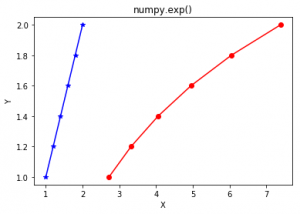Python numpy.exp()
numpy.exp(array, out = None, where = True, casting = ‘same_kind’, order = ‘K’, dtype = None) :
这个数学函数帮助用户计算输入数组中所有元素的指数。
参数 :
array : [array_like]输入数组或对象的元素,我们需要测试。
out : [ndarray, optional]输出数组,其尺寸与输入数组相同,与结果放在一起。
**kwargs : 允许你向一个函数传递长度可变的关键字参数。当我们想在一个函数中处理命名的参数时,它就会被使用。
where : [array_like, optional]真值意味着在该位置计算通用函数(ufunc),假值意味着在输出中不考虑该值。
返回 :
一个带有输入数组所有元素的指数的数组。
代码1:
# Python program explaining
# exp() function
import numpy as np
in_array = [1, 3, 5]
print ("Input array : ", in_array)
out_array = np.exp(in_array)
print ("Output array : ", out_array)
输出 :
Input array : [1, 3, 5]
Output array : [ 2.71828183 20.08553692 148.4131591 ]
代码2:图形表示法
# Python program showing
# Graphical representation of
# exp() function
import numpy as np
import matplotlib.pyplot as plt
in_array = [1, 1.2, 1.4, 1.6, 1.8, 2]
out_array = np.exp(in_array)
y = [1, 1.2, 1.4, 1.6, 1.8, 2]
plt.plot(in_array, y, color = 'blue', marker = "*")
# red for numpy.exp()
plt.plot(out_array, y, color = 'red', marker = "o")
plt.title("numpy.exp()")
plt.xlabel("X")
plt.ylabel("Y")
plt.show()
输出 :

 极客教程
极客教程